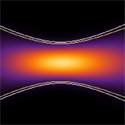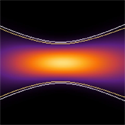Power management
High-power laser systems are basic tools in atomic and plasma physics where interactions of electromagnetic fields with matter are studied at extreme conditions. Such laser systems usually start small: pulses from a stable, low-power laser with a precisely controlled frequency are sent into amplifiers that boost the pulse energy in stages, but often with the trade-off that pulse repetition rate must be sacrificed. Frontier research requires squeezing every last drop of energy out of the amplifiers, yet no simple theory exists for optimizing gain in a geometry where the input beam is being focused in the amplifying medium. Focused beams are more intense and should, in principle, increase the efficiency with which power is extracted from the amplifier.
In a paper in Physical Review A, Akira Ozawa and colleagues at the Max-Planck Institute of Quantum Optics in Garching and the Fraunhofer Institute in Jena, both in Germany, now report a model for single-pass laser amplifiers that includes the effects of beam focusing and should allow optimum choices of operating parameters without decreasing the repetition rate. The authors have compared output power given by their simpler numerical calculations with a much more complex full-wave simulation, as well as experimental data, and find good agreement. Overall, the results permit a more straightforward optimization of experimental parameters that are ordinarily difficult to handle. – David Voss





